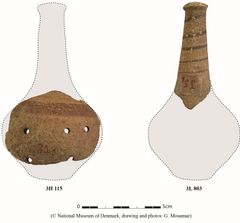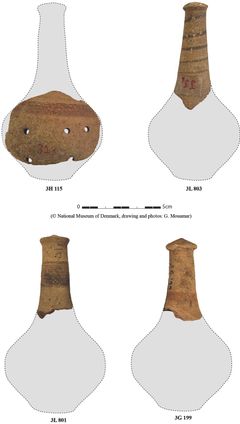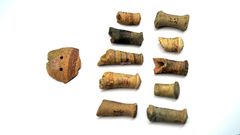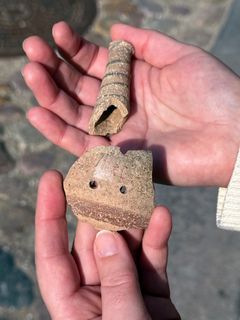New research: Baby toys were mass produced in Early Bronze Age Syria
Scholars at the National Museum of Denmark in collaboration with Archéorient CNRS in France and the University of Milan in Italy have identified 4500-year-old baby rattles that were produced by professional potters in an ancient city in Syria. They were probably sold at the market to parents who wanted to entertain – or distract – their children.

Forget about BRIO and LEGO. Already 4500 years ago, parents bought professionally produced toys for their babies. The production of clay rattles was a veritable industry for potters at the time.
This is revealed by new research carried out at the National Museum of Denmark and published in the scientific journal Childhood in the Past.
The mixture of clay from which the rattles are made is of the exact same composition as the professionally made pottery from the ancient city of Hama where they were found, showing that the rattles were part of the potters’ professional range alongside other ceramic wares.
The rattles were likely sold at the market.
“It shows us that parents in the past loved their children and invested in their wellbeing and their sensorimotor development, just as we do today. Perhaps parents also needed to distract their children now and then so that they could have a bit of peace and quiet to themselves. Today, we use screens, back then it was rattles,” says senior researcher at the National Museum of Denmark Mette Marie Hald, one of the co-authors of the study.
Rattles – and children – are overlooked in archaeology
Although the rattles contained little pieces of clay or small pebbles, which enabled the production of sound, the noise they make is so low that the scholars rule out the possibility that they might have been used as musical instruments.
Moreover, the handles are very small and not suitable for adults, but they fit exactly into a small child’s hand.
“When you find items such as these, the tendency in archaeology has been to interpret them as musical instruments or even cultic objects when, really, they are something much more down-to-earth and relatable such as toys for children,” says Mette Marie Hald.
Tip of the iceberg
The team of researchers identified a total of 19 rattles from an Early Bronze Age residential quarter within the city of Hama. This is the largest collection of this type of rattles from the Near East.
However, Mette Marie Hald estimates that there must be many more rattles from archaeological sites stored in museum collections, but they are difficult to recognize as such from their fragments.
For this reason, the scholars have put together a manual to identify rattles, says Mette Marie Hald.
“I hope that this will provide us with a greater insight into the world of children in the past. From an economic point of view, it is fascinating that already 4500 years ago, there was an actual market for commercial toys. At the same time, it is touching to get a glimpse of a family’s everyday life – perhaps a parent stopped at a market stand on their way home and bought a rattle as a present for their child. This scenario is entirely recognisable to us today.”
The study was financed by Independent Research Fund Denmark.
Kontakter
Mette Marie HaldSenior Researcher, the National Museum of Denmark
Tlf:+45 41206175mette.marie.hald@natmus.dkJohn Fhær Engedal NissenKommunikationsmedarbejderNationalmuseet
Tlf:+45 41 20 68 49jni@natmus.dkBilleder







Nationalmuseet
Nationalmuseet er Danmarks kulturhistoriske hovedmuseum. Det ligger i Prinsens Palæ i København, hvor det har haft adresse siden 1849.
Nationalmuseet består foruden af besøgsstedet i København også af en forsknings-, samlings og bevaringsafdeling, der tager sig af konservering og bevaring af Danmarks kulturskatte samt forskning i både kulturhistoriske og naturvidenskabelige emner.
Der er 18 besøgssteder knyttet til Nationalmuseets organisation, som Rane Willerslev er direktør for.
Følg pressemeddelelser fra Nationalmuseet - Museer, forskning og bevaring
Skriv dig op her, og modtag pressemeddelelser på e-mail. Indtast din e-mail, klik på abonner, og følg instruktionerne i den udsendte e-mail.
Flere pressemeddelelser fra Nationalmuseet - Museer, forskning og bevaring
Klimaengagerede unge sejler igen på tøjbyttetogt - besøger 13 byer30.6.2025 08:32:41 CEST | Pressemeddelelse
Nationalmuseets skonnert Bonavista er lastet med klimaengagerede unge og genbrugstøj og sejler rundt til 13 danske byer, hvor der bliver opstillet til tøjbyttemarked.
Anders Foghs jakkesæt fra malingangreb kommer på Nationalmuseet3.6.2025 05:30:00 CEST | Pressemeddelelse
Den tidligere statsministers jakkesæt fra malingangrebet i 2003 kommer nu på Nationalmuseet og bliver en del af den danske kulturarv. Genstanden vidner om forandret politisk aktivisme i Danmark i forbindelse med vores militære engagement i udlandet.
’Arkæologiens Oscar’ går til sønderjysk arkæolog23.5.2025 16:14:10 CEST | Pressemeddelelse
Erik Westerby-prisen går i år til Lennart Secher Madsen, arkæolog ved Museum Sønderjylland, for sit lange, seje træk i arkæologiens tjeneste og for at fremhæve Sønderjyllands særlige status. Lektor Tim Flohr får rejselegat for sin utraditionelle, men inspirerende tilgang til arkæologien.
Ny forskning: Baby-legetøj blev masseproduceret i oldtiden19.5.2025 08:52:17 CEST | Pressemeddelelse
Forskere på Nationalmuseet har identificeret 4.500 år gamle baby-rangler, som blev produceret af professionelle pottemagere i en oldtidsby i Syrien. De blev formentlig solgt på markedet til forældre, der ville forkæle – eller distrahere – deres børn.
Ny podcast om hvordan befrielsen blev til frihed2.5.2025 10:47:06 CEST | Pressemeddelelse
På 80-års-dagen for befrielsen udgiver Nationalmuseets mediehus Vores Tid første episode i podcast, der fortæller historien om de udstødte og beundrede, der skulle starte helt nye liv, da Anden Verdenskrig sluttede
I vores nyhedsrum kan du læse alle vores pressemeddelelser, tilgå materiale i form af billeder og dokumenter samt finde vores kontaktoplysninger.
Besøg vores nyhedsrum